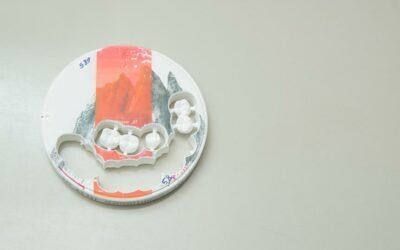Do you ever wonder what mold on pineapple looks like?
In this article, we'll give you a concise and informative guide on identifying different types of mold on pineapple. You'll learn about the visual characteristics of mold and how to spot signs of mold-related spoilage.
Plus, we'll share some tips on how to prevent mold growth on your beloved pineapple.
Get ready to become an expert in recognizing mold on pineapple!
Key Takeaways
- Mold on pineapple can appear as fuzzy or powdery patches on the surface.
- The color of mold on pineapple can range from white to green, blue, or black.
- Mold on pineapple may start small and spread over time, and it may have a slimy texture.
- Visible mold growth, strong musty odor, and texture changes such as sliminess or mushiness indicate spoilage, and the entire pineapple should be discarded if mold is present.
Identifying Mold on Pineapple
To identify mold on pineapple, start by examining the surface for any fuzzy or discolored patches. Mold on pineapple usually appears as a fuzzy growth or a powdery substance on the fruit's surface. It can range in color from white to green or even black. Keep in mind that mold may not always be visible to the naked eye, especially if it's in its early stages.
If the pineapple has a strong musty odor or tastes off, it might indicate the presence of mold. Additionally, if the fruit feels slimy or has a soft, mushy texture, it could be a sign of mold growth. When inspecting the pineapple, pay close attention to any areas that are bruised, damaged, or overly ripe, as mold tends to thrive in these conditions.
If you do find mold on your pineapple, it's best to discard it to avoid any potential health risks. Remember to always store your pineapple properly in a cool, dry place to prevent mold growth.
Common Types of Mold on Pineapple
There are several common types of mold that can be found on pineapple. One of the most prevalent molds is called Penicillium. It appears as blue or green spots on the pineapple's skin and can sometimes spread to the flesh.
Another common type is Aspergillus, which is characterized by a fuzzy, gray or black mold that grows on the surface of the fruit.
Rhizopus is another type of mold that can be found on pineapples. It forms a white or grayish mold with a velvety texture.
Fusarium is yet another type that can appear on pineapples, typically as pink or reddish patches on the skin.
Lastly, Alternaria is a type of mold that creates dark, black spots on the pineapple's surface. These molds can cause the fruit to become soft, slimy, and emit an unpleasant odor.
It's important to discard any pineapple that shows signs of mold, as consuming it can lead to health issues.
Visual Characteristics of Mold on Pineapple
You can easily identify mold on pineapple by its distinct visual characteristics. When mold begins to grow on pineapple, it typically appears as fuzzy or powdery patches on the surface. The color of the mold can range from white to green, blue, or black, depending on the type of mold present. These patches may start small and spread over time, covering a larger area of the fruit.
In some cases, the mold may have a slimy texture. As the mold develops, it can also cause the pineapple to become soft and mushy in the affected areas. Mold on pineapple can sometimes have a musty or unpleasant odor, which is another indicator of its presence.
It's important to note that consuming moldy pineapple can be harmful to your health, as it may contain mycotoxins that can cause allergic reactions or other adverse effects. Therefore, if you spot mold on a pineapple, it's best to discard the fruit to avoid any potential health risks.
Signs of Mold-Related Spoilage on Pineapple
If you notice any signs of mold on your pineapple, it's important to be aware of the potential spoilage that may have occurred. Mold on pineapple not only affects its appearance but can also indicate that the fruit is no longer safe to consume. Here are some signs that indicate mold-related spoilage on pineapple:
| Signs of Mold-Related Spoilage | Description | Action to Take |
|---|---|---|
| Visible mold growth | You may see fuzzy or powdery patches of mold on the surface of the pineapple. | Discard the entire pineapple, as the mold can penetrate deep into the fruit. |
| Unpleasant smell | A strong, musty odor coming from the pineapple can be a sign of spoilage. | Do not consume the pineapple and dispose of it properly. |
| Texture changes | If the pineapple feels slimy or mushy to the touch, it may be a result of mold growth. | Avoid eating the pineapple, as the texture changes are likely due to spoilage. |
How to Prevent Mold Growth on Pineapple
To prevent mold growth on pineapple, it's important to take certain precautions. Here are five simple steps you can follow to keep your pineapple fresh and mold-free:
- Store the pineapple in a cool, dry place: Mold thrives in warm and moist environments, so it's essential to store your pineapple in a cool and dry area. Avoid leaving it in direct sunlight or near a heat source.
- Handle with clean hands: Before handling the pineapple, make sure your hands are clean. This will prevent the transfer of bacteria or mold spores onto the fruit's surface.
- Remove any damaged or bruised areas: Inspect the pineapple for any signs of damage or bruising. These areas are more susceptible to mold growth. Cut them off before consuming or storing the pineapple.
- Keep it well-ventilated: Proper airflow around the pineapple can help prevent moisture buildup, which can lead to mold growth. Avoid sealing it in an airtight container and instead opt for a breathable storage bag or container.
- Consume or freeze it promptly: Pineapple is best consumed when it's fresh. If you can't finish it in one sitting, consider freezing the remaining slices or chunks to avoid mold growth.
Conclusion
In conclusion, mold on pineapple can appear as fuzzy patches or spots that are green, white, or black in color. It's important to identify and discard any moldy pineapple to avoid consuming spoiled fruit.
To prevent mold growth on pineapple, store it in a cool and dry place, avoid bruising the fruit, and consume it within a few days of purchase. Proper storage and handling can help maintain the freshness and quality of pineapple.





0 Comments